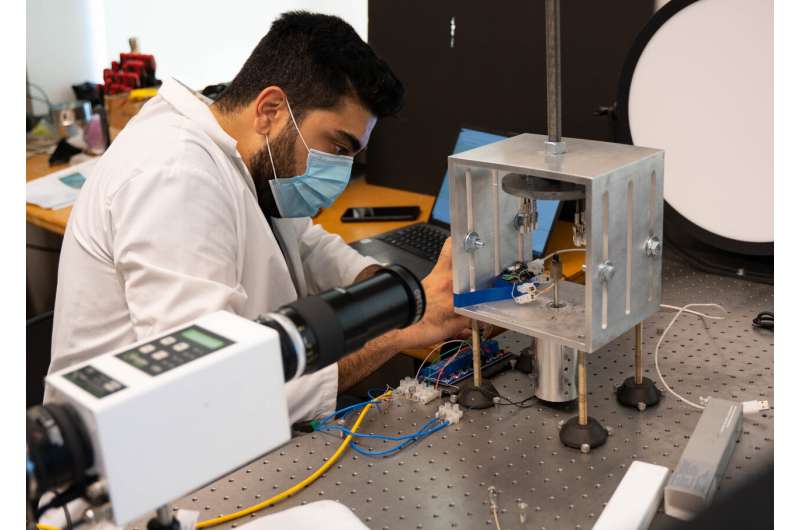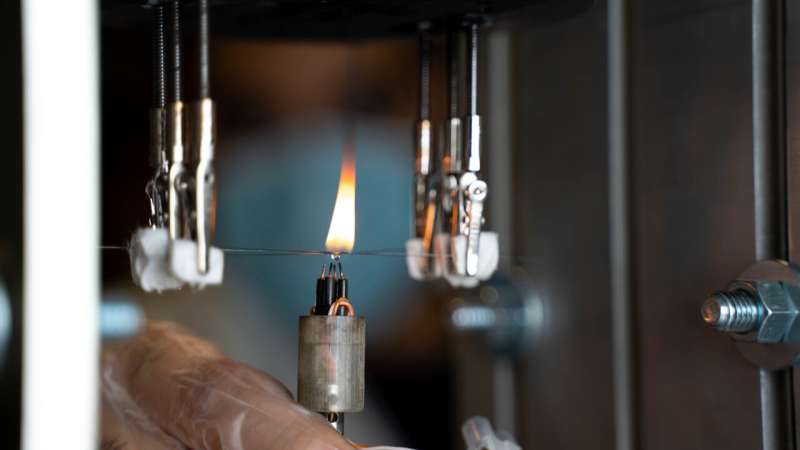How aircraft can get higher, be greener using doped fuels

The goal of creating a cleaner fuel for aircraft engines is creating a spark at UBC Okanagan.
A team of researchers studying the burning rate of nanomaterials in liquid fuels believe they have created a recipe for a clean-burning, power-boosting aircraft fuel. The project is a collaboration between the School of Engineering’s Combustion for Propulsion and Power Laboratory (CPPL) and its Nanomaterials and Polymer Nanocomposites Laboratory.
Inside the CPPL, researchers watch a bright consistent flame as it dances over wires containing droplets of liquid fuel enriched with nanomaterials. The team is investigating the combustion characteristics of microscopic graphene oxide inside fuel.
Their experiment measures the ignition delay, burn rate and speed by which the graphene particles and fuel separate into smaller particles.
“Working with our industry partner, ZEN Graphene Solutions, we are assessing how the burn rate of this mixture can potentially improve its combustion properties,” explains lead author and doctoral candidate Sepehr Mosadegh.
Mosadegh and his supervisor, Assistant Professor Dr. Sina Kheirkhah, develop technology, tools and knowledge for next-generation energy and aerospace-related applications. In this case, they hope their results will lead to a future of cleaner and more powerful aircraft.

“When it comes to fuel, we are always searching for a consistent response of the fuel within key parameters as they relate to how it ignites, burns and maintains strength,” says Mosadegh. “Most people have a general understanding of the composition of gasoline and jet fuel, and that it is a mixture of many hydrocarbons. But they may not think about how combining these with nanomaterials and burning them can result in dramatically more powerful and cleaner engines.”
Using ultrafast and intensified cameras and microscopy analysis, the researchers were able to study the combustion rate of the doped fuel. They found that the addition of graphene oxide nanomaterials into ethanol improved the burn rate by about eight per cent. This improvement in combustion, the researchers explain, can help reduce the carbon footprint of aircraft. And at the same time, make aircraft more powerful.
“The recipe for cooking the nanomaterials was developed by the co-author of this study Ahmad Ghaffarkhah. who works in our partner lab,” says Dr. Kheirkhah. “We have published the results for doped ethanol, and we have promising results for other liquid fuels such as jet A and diesel.”
The addition of nanomaterials to liquid fuels alters the heat transfer and the fuel’s evaporation rate, impacting the overall burning rate.
“However, getting just the right mixture of nanomaterials and liquid fuel is key to improving combustion. Particularly in aircraft engines,” Dr. Kheirkhah adds.
Sepehr Mosadegh et al, Graphene oxide doped ethanol droplet combustion: Ignition delay and contribution of atomization to burning rate, Combustion and Flame (2021). DOI: 10.1016/j.combustflame.2021.111748
Citation:
How aircraft can get higher, be greener using doped fuels (2021, November 2)
retrieved 2 November 2021
from https://techxplore.com/news/2021-11-aircraft-higher-greener-doped-fuels.html
This document is subject to copyright. Apart from any fair dealing for the purpose of private study or research, no
part may be reproduced without the written permission. The content is provided for information purposes only.
For all the latest Technology News Click Here
For the latest news and updates, follow us on Google News.

